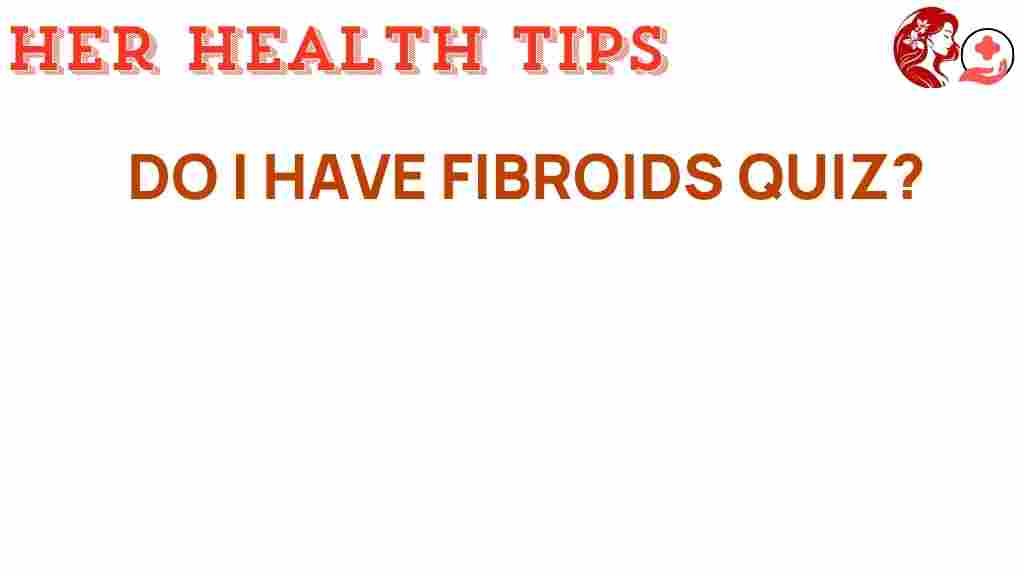Unraveling the Mystery: Do You Have Fibroids? Take the Quiz!
Fibroids are non-cancerous growths that develop in or on the uterus. They are also known as uterine leiomyomas or myomas. While many women with fibroids experience no symptoms, others may face significant health issues. Understanding fibroids is vital for women’s health, especially as they can lead to pelvic pain, heavy menstrual bleeding, and other complications. In this article, we will explore the symptoms of fibroids, provide a health quiz to help you assess your condition, and offer medical insights on diagnosis and treatment options.
What Are Fibroids?
Fibroids are muscular tumors that grow in the wall of the uterus. They can vary in size from tiny seedlings to large masses that can distort the shape of the uterus. Fibroids can develop in different locations:
- Intramural fibroids: These grow within the uterine wall.
- Subserosal fibroids: These extend outside the uterus.
- Submucosal fibroids: These grow into the uterine cavity.
Symptoms of Fibroids
Understanding the symptoms of fibroids is crucial for early diagnosis. Common signs include:
- Heavy menstrual bleeding: Many women experience prolonged or heavy periods.
- Pelvic pain: Some women may have chronic pain in the pelvic area.
- Frequent urination: Large fibroids can press on the bladder.
- Back pain: Fibroids can lead to discomfort in the lower back.
- Abdominal swelling: A noticeable enlargement of the abdomen may occur.
If you experience any of these symptoms, it may be time to take a closer look at your uterine health.
Take the Health Quiz: Do You Have Fibroids?
To help you assess whether you might have fibroids, we’ve created a simple health quiz. Answer the following questions:
- Do you experience heavy menstrual bleeding?
- Have you noticed any pelvic pain or pressure?
- Do you often feel the need to urinate?
- Have you experienced changes in your menstrual cycle?
- Do you have a family history of fibroids?
Count how many of these symptoms you relate to. If you answered ‘yes’ to two or more questions, it may be advisable to consult a healthcare professional for further evaluation.
Diagnosis of Fibroids
If you suspect you have fibroids based on your symptoms, seeking a diagnosis is essential. Here are the common methods used to diagnose fibroids:
- Pelvic exam: A healthcare provider will manually check for any abnormalities in your abdomen and pelvic area.
- Ultrasound: This imaging test uses sound waves to create images of the uterus and can help identify fibroids.
- MRI: Magnetic Resonance Imaging provides detailed images of the uterus and can help determine the size and location of fibroids.
- Hysteroscopy: This procedure involves inserting a small camera into the uterus to visualize the fibroids directly.
Awareness of your symptoms and understanding the diagnosis process are vital steps in managing your uterine health.
Troubleshooting Tips for Managing Fibroids
While you await a diagnosis or treatment plan, there are several strategies you can implement to manage symptoms associated with fibroids:
- Track your symptoms: Keeping a record of your menstrual cycle and any symptoms can help your doctor understand your condition better.
- Stay hydrated: Drinking plenty of water can help alleviate some pelvic discomfort.
- Manage stress: Practices such as yoga and meditation can be beneficial for overall health.
- Healthy diet: Eating a balanced diet rich in fruits, vegetables, and whole grains may help improve your overall well-being.
Medical Insights About Fibroids
Fibroids are often treated based on their size, location, and the severity of symptoms. Treatment options include:
- Watchful waiting: If you have mild symptoms, your doctor may recommend monitoring the situation.
- Medications: Hormonal medications can help manage symptoms such as heavy bleeding.
- Minimally invasive procedures: Options such as uterine artery embolization or laparoscopic myomectomy can remove fibroids with less recovery time.
- Surgery: In severe cases, a hysterectomy may be recommended, which involves removing the uterus.
It’s essential to discuss your symptoms and treatment options with your healthcare provider to determine the best course of action for your situation.
Raising Awareness About Fibroids
Many women are unaware of what fibroids are and how they can impact their health. Raising awareness about fibroids is crucial for early detection and treatment. Here are some ways to promote awareness:
- Educate yourself: Read about fibroids and their symptoms to be better informed.
- Share information: Talk to friends and family members about the importance of uterine health.
- Consult professionals: Encourage women to seek advice from healthcare providers if they experience symptoms.
For more detailed information about fibroids, you can visit the American College of Obstetricians and Gynecologists.
Conclusion
Understanding fibroids is essential for women’s health. By recognizing the symptoms, taking the health quiz, and seeking a proper diagnosis, women can take significant steps towards managing their uterine health. If you suspect you have fibroids, don’t hesitate to consult a healthcare professional for guidance and support. Remember, awareness and education are key to taking control of your health. Stay informed, and take charge of your uterine health today!
This article is in the category Reproductive and created by HerHealthTips Team
